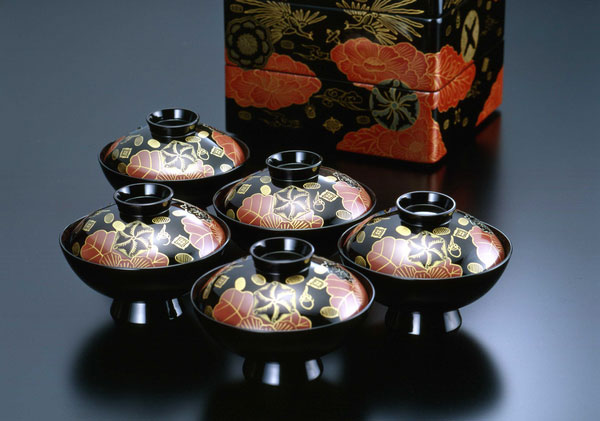 Photo:Fukushima Prefecture
Photo:Fukushima Prefecture
- Lacquerware
- Fukushima
Aizu lacquerware Aizu nuri
Traditional techniques passed down from the Edo period
Auspicious drawings and charming versatile decorations
Description
What is Aizu lacquerware ?
Aizu lacquerware (called Aizu nuri in Japanese) is lacquerware made in the Aizu region of Fukushima prefecture. During the manufacturing process, the craft is classified into round pieces, such as bowls, and flat pieces such as trays or stationery boxes. Patterns combining pine, bamboo, plum, and hamaya (ritual arrows used to drive away devils) are called Aizu pictures. The distinct characteristics of Aizu lacquerware are its auspicious designs and decorations. Although during the Edo period (1603-1868) the colors black, vermillion, and green were often used, in modern times an opaque reddish brown or yellowish vermillion has been used, and color schemes created using a limited number of colors have also become an attraction. In addition, since the carved grooves are finer and shallower than in lacquerware produced in other areas, the decoration has a soft appearance. For the top coating, Aizu lacquerware employs techniques like coating with tetsusabinuri, which has an astringency similar to that of cast metal, achieved by using rust lacquer, or kinmushikuinuri which uses rice chaff to create a pattern. There are many other kinds of top-coating techniques, such as kijironuri, which brings out the beauty of the wood grain, or hananuri, which creates gloss through the addition of oil. Each technique requires the artisan to have advanced skills.
For surface decoration, keshifun maki-e is the representative technique of Aizu lacquerware. Pictures are drawn with a lacquered covered brush, and fine gold dust is applied using cotton wadding.
History
The story that has been passed down is that Aizu lacquerware originated with lacquer trees that were planted in Aizu during the Muromachi period (1336-1573). Ujisato GAMO, the feudal lord of Aizu in 1590, encouraged the Aizu lacquerware industry and helped to establish the craft. He invited wood and lacquer specialists from Hino in Omi province (present day Shiga prefecture), to instruct artisans in the most recent technology, spurring the further development of Aizu lacquerware. As a result, Aizu became a major production area handling the entire process from lacquer tree cultivation to decoration. During the Edo period (1603-1868), effort was put into the technological innovation of Aizu lacquerware, while it received generous protection by successive lords of the domain. All this succeeded to such an extent that the lacquerware came to be exported to China and the Netherlands.
Aizu got involved in the Boshin War, a civil war that occurred at the end of the Edo period, and suffered a devastating blow. However, thanks to subsequent reconstruction Aizu regained its vibrancy as one of the leading areas of lacquerware production in Japan by the middle of the Meiji period (1868-1912).
Production Process
- 1. Wood carving
Aizu lacquerware comes in two forms: round pieces, such as bowls and trays, and flat pieces, such as tiered food boxes. The materials used for the wooden bases of round pieces are horse chestnut and zelkova while the wood for flat pieces comes from trees like magnolia, zelkova, and paulownia trees. After the wood has been cut into an approximate shape, it is dried naturally for more than three years in order to remove the lye and astringency of the wood.
- 2. Wood lathe grinding
The sufficiently dried wooden base is cut into round pieces and hand shaved with a lathe by wood specialists. When using a wood lathe, subtle differences in the shape can be brought out through differing levels of force.
Meanwhile, the craftsmen who make flat pieces are traditionally called sowashi. During the cutting of the wood base, many different kinds of wood planes and excellent technique are required in order to create the desired shape.
- 3. Preparing the undercoating
The sabishitaji or rust undercoat is a mixture of raw lacquer and polishing powder. Painting it on the wood base gives a flat and smooth finish. This step is repeated several times.
- 4. Polishing
The undercoating is polished with a grindstone to make the lacquer adhere better and to eliminate the unevenness of the wooden base.
- 5. Lacquering
For lacquering, there is an undercoating, intermediate coating, and top coating. After lacquer is applied in the undercoating and intermediate coating, there is a final check for scratches. Hananuri is commonly used as top coat. It has to be applied carefully to prevent dust adhesion, unevenness, and to maintain the gentle texture of the piece.
Upon the completion of top coating, the piece is dried in a drying chamber, and so it dries uniformly, it is turned over from time to time.
- 6. Maki-e
Maki-e is a method that makes use of the adhesive quality of lacquer by sprinkling powder of gold, silver, or other colors like vermillion, yellow, or blue onto a lacquer drawing.
Facility Information
Aizu Machikata Densyokan
-
Address
-
Tel.+81-242-22-8686
-
ClosedMondays (open if Monday is holiday and closed the next day) and December 31 to January 4
-
Business Hours9am to 6pm
-
Website
Other Lacquerware
- Wajima lacquerware
- Kamakura-bori lacquerware
- Tsugaru lacquerware
- Aizu lacquerware
- Yamanaka lacquerware
- Kawatsura lacquerware
- Echizen lacquerware
- Joboji lacquerware
- Kiso lacquerware
- Hidehira lacquerware
- Kagawa lacquerware
- Ryukyu lacquerware
- Takaoka lacquerware
- Wakasa lacquerware
- Hida-shunkei lacquerware
- Ouchi lacquerware
- Kanazawa lacquerware
- Kishu lacquerware
- Kyo laquerware
- Odawara lacquerware
- Naruko lacquerware
- Niigata lacquerware
- Murakami carved lacquerware

































































































































































































































































































